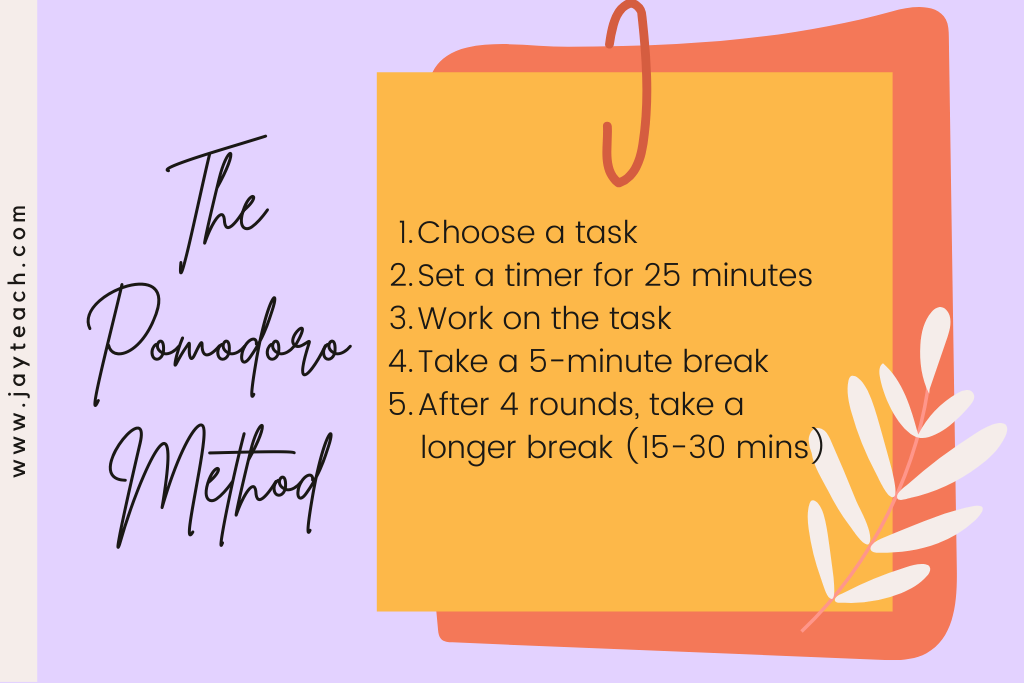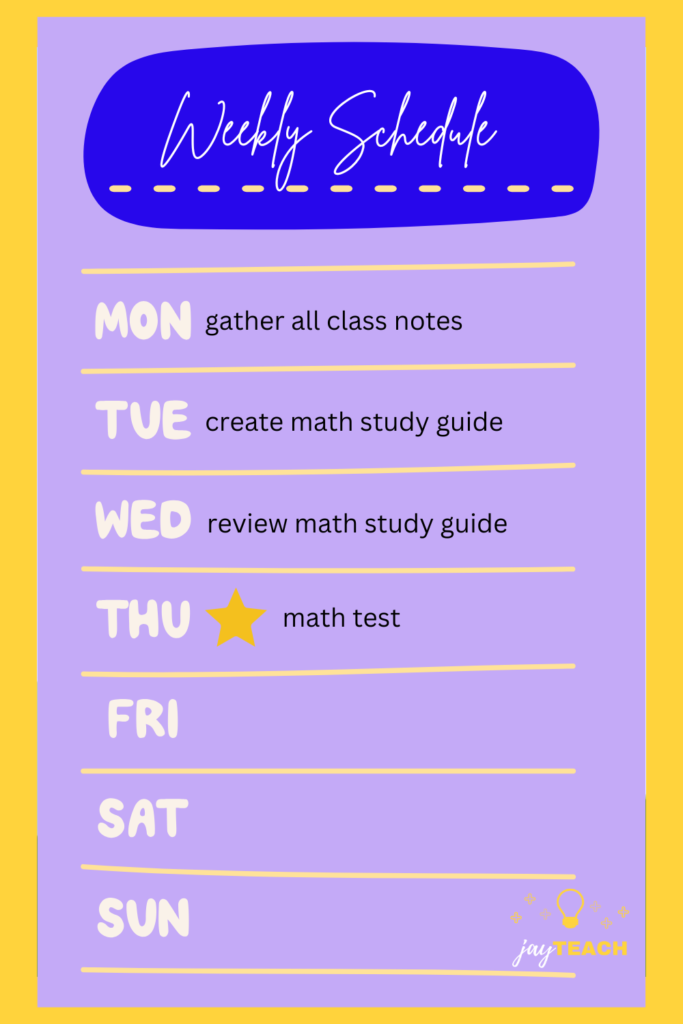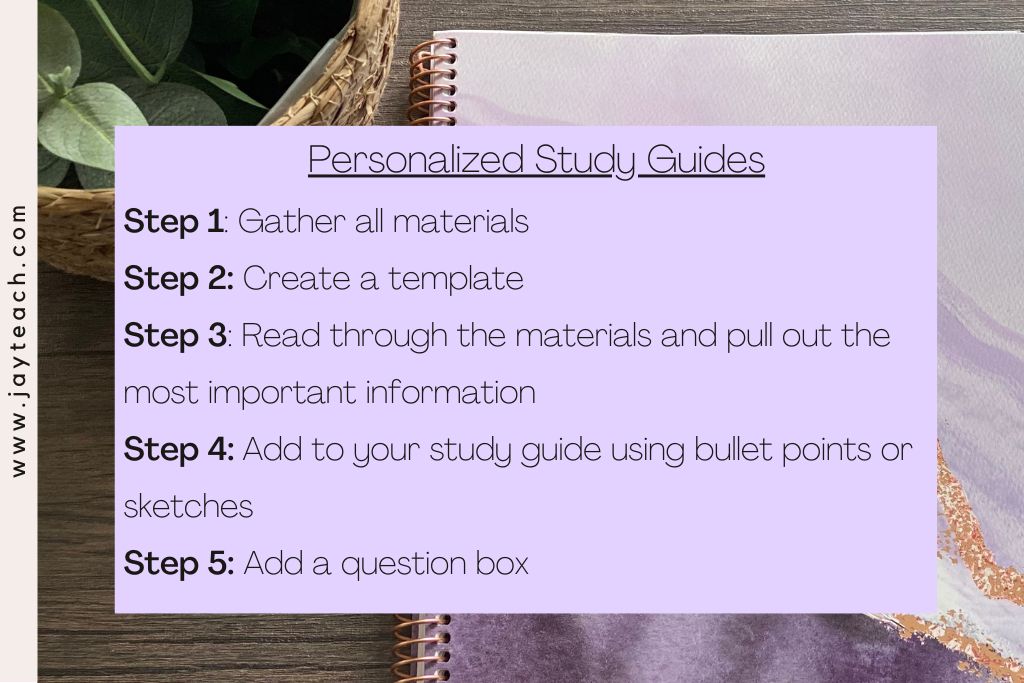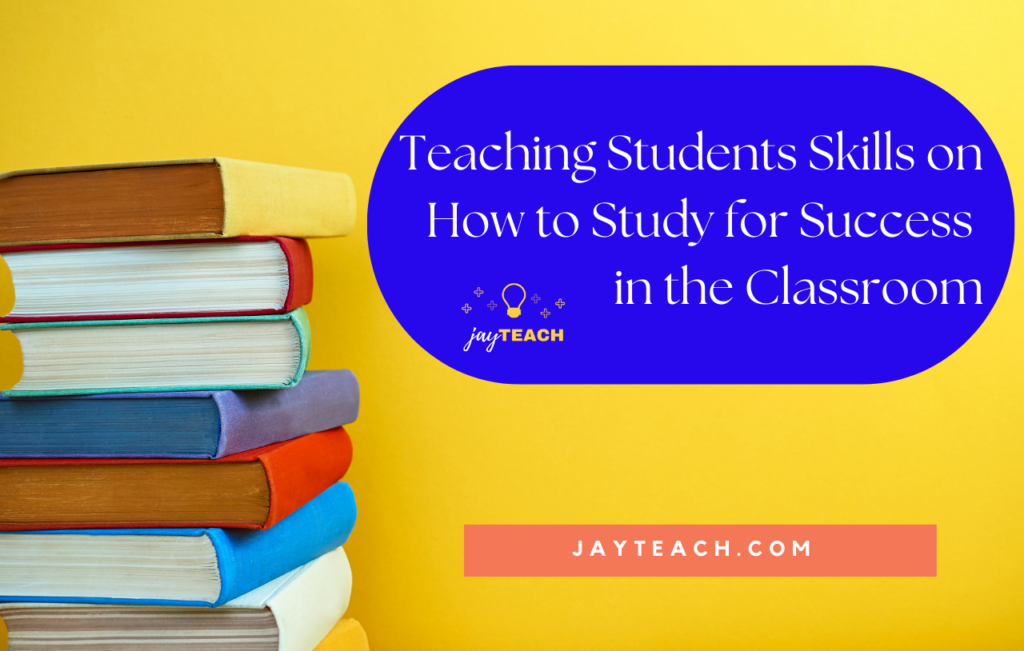Teaching students skills on how to study is one of the most important parts of what I do. While study skills come naturally to some, developing study habits is more challenging for others. If you are faced with a student who pulls all-nighters, memorizing and cramming loads of information just to quickly forget it all, I know exactly what you’re experiencing. Luckily, I have compiled my most proven techniques to teach students skills on how to study for success in the classroom.
A little background
Before we get into the specifics, I want to take a minute to introduce myself! I am Jaymee: a certified teacher, learning specialist, college essay coach, and founder of JayTeach. Feel free to check out my website for all things education! Every study strategy I discuss in this blog post are methods that I teach in my executive functioning sessions.
I will never forget a recent session I had with a middle schooler. Let’s call her Riley for the sake of the story. Riley and I were working on developing strategies for testing. She had an upcoming science test, so the plan was to teach her how to study for the exam in a way that allowed her to feel prepared without feeling overwhelmed. Now right before the session, I received an email from her dad. It went something like this, “Riley created a study guide for next week’s science test. The problem is, she doesn’t understand anything on it.”
This was the moment I realized that we have to teach kids how to study using concrete study strategies. Studying does not come naturally all the time and that is exactly what we are getting into today. Keep reading to learn how to teach students skills on how to study for success in the classroom. Let’s learn some explicit test study tips!

Study Tip #1: Setting the study environment
One of the first questions I ask my students is, “Where do you study?” Sometimes they are thrown off by this question, completely missing its importance in the grand testing scheme. As adults, we have preferences. Some of us make a hot vanilla latte, light a candle, open a window, and sit at our desks ready to take on the world. Others prefer a more laid-back work environment– sitting on a couch with jazz music playing in the background. The point is, we have environmental preferences for our workspace and so do students. Encouraging students to think about their study environment allows them to have agency over their study experience. Also, our environment includes our distractions. Personally, when I have a clean desk and a flipped-over phone, I am a productivity machine!
The other day, during a tutoring session, a student said to me, “Studying has been hard because I keep going on my phone.” What I responded might shock you.
“Ok, so move your phone out of your room.” My student came back the following week and said, “It worked!” Study skills may seem obvious to you, but it doesn’t mean it is obvious to our students.
Additionally, I have my students sketch a picture of their ideal work environment and then give them time to create it.
Study Tip #2: Using the Pomodoro Method
I absolutely love this time management technique and it couldn’t be a simpler study skill: set a timer for 25 minutes, engage in focused work until the timer goes off, then take a 5-minute break. After four consecutive rounds, take a longer break (15-30 minutes).

I use this time management tool with my students all the time. Taking regular breaks may seem obvious to some, but many of my students believe that studying longer=studying stronger. This simply isn’t the case: taking regular breaks allows for our on-task time to be much more productive.
During the break time, I always suggest switching up the environment – walking into a different room, having some water, or even stretching. Science supports the idea that smaller pockets of focused time on a particular task are far more beneficial than long stretches of unfocused time.
There are many video timers for the Pomodoro Method. I like to give my students tangible classroom timers. There are also Pomodoro Method apps, but the goal is to keep students away from their phones!
Study Tip #3: Breaking up a task into smaller parts
One of my favorite organizational tools is breaking up a large task into smaller, more actionable pieces. I can honestly write a book about this. My passion for compartmentalizing is real and is a life skill I could not live without. Let me tell you what I mean. After encouraging my student to use a planner, I use and love Bloom daily planners, by the way, he proudly showed me that he used it to prepare for his math test. It looked something like this:
Wednesday: study for math
Thursday: math test
As much as this was progress, I noticed two important things: 1. He gave himself only one day to study, and 2. The language “study for math” was far too broad. What does “study for math” actually look like? How do you know when you’re done? This turned into a teachable moment where I taught him ways to break down this large task into actionable steps. Here’s what we came up with:

Study Tip #4: Creating personalized study guides
Remember my student Riley from earlier? The one who created a science study guide but had no idea what it all meant? She is the inspiration behind this strategy for testing. The overall point is this: a student’s study guide should make sense to him or her. It does not matter if it makes sense to us. I repeat: it does not matter if it makes sense to us. Here is the step-by-step method I teach my students.
Step 1: Gather all relevant materials (teacher’s study guide, class notes, etc.)
Step 2: Create your own study guide template (including important vocabulary and ideas)
Step 3: Go through the materials and use concision to weed through unnecessary information
Step 4: Use sketch notes or bullet points to add important information to your study guide
Step 5: Add a question box

Ultimately, personalized study guides help students come up with a study plan and provide them with a document that is user-friendly. My favorite part of this approach is the “question box.” If a student has questions during the study process, they write them down in the question box. Not only does this make for more efficient use of the time, but contains all of the questions in one place. Many times, my students answer their own questions along the way. If they are unable to, they can research the questions or ask a teacher at the end of the process.
As I have mentioned, we need to teach children skills to study explicitly. If your student could benefit from learning these skills, feel free to visit my website to learn more about how I can help.
Studying can be overwhelming, but it doesn’t have to be. I genuinely hope you take these skills on how to study and teach them to your children or students for ultimate success in the classroom.
Related Articles:
Time-Saving Ways to Teach the Units of Study by Lucy Calkins

